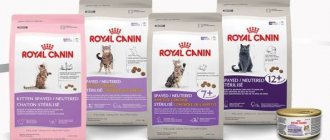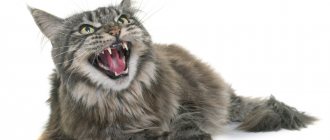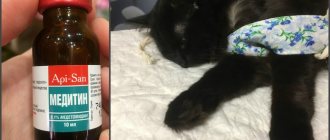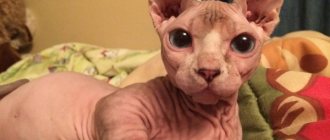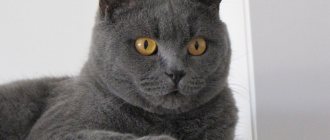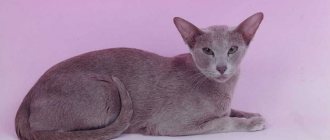Pets, like people, can experience weight problems. Cats living in city apartments often lead an inactive lifestyle and receive excess nutrition. As a result, your pet develops excess fat cells, which negatively affect their overall health. Animals experience problems with cardiac activity and are prone to developing arthritis and other pathologies of internal organs. Therefore, the cat’s weight must be maintained within certain limits, and for this you should know the accepted norms, depending on age and breed.
Visual inspection
To determine the condition of the animal, it is necessary to carefully examine its physique. The condition of the limbs and abdomen is determined when looking at the profile, the lumbar region and waist are assessed when viewed from above. The weight of a cat can also be “calculated” by manual palpation. To do this, the area of the ribs is felt with your fingers. Moreover, if the bones stick out at the slightest pressure, then the animal is malnourished; if you need to make an effort to palpate them, then, most likely, the pet is obese.
After the ribs, the waist and abdomen area is assessed. In cats, it is very sensitive, so you must be careful when palpating. If you run two palms from the waist to the pelvic bones, you should get an hourglass shape. If this sensation does not arise, then the cat is most likely overweight.
Next, the abdomen is examined. Softness should be felt under your fingers. But if it hangs down a lot or is swollen, then nutritional adjustments are necessary. A sunken belly indicates a lack of nutrition or illness.
Signs of normality and deviations in weight up or down
In order to determine without weighing an animal whether its body weight is within the normal range, or whether it is obese or, conversely, exhausted, you need to take a close look at the animal and examine its body.
Signs of being underweight:
- the bones of the ribs and pelvis are clearly visible, protruding excessively through the skin;
- visible insufficiency of muscle fibers;
- When palpating the chest, a layer of subcutaneous fat is not felt.
Maximum low limit of permissible low weight:
- the bones of the ribs and pelvis are clearly distinguished;
- the waist is visible;
- in the chest area you can feel the subcutaneous fat layer, which is absent on the abdomen.
The norm indicator, which is considered ideal for an animal of any breed:
- all body proportions are perfectly observed;
- the bones of the ribs and pelvis are poorly visible, but they can be felt;
- the waist varies;
- the presence of subcutaneous fat in the chest area;
- There is a small, thin accumulation of subcutaneous fat on the abdomen.
Signs indicating that an animal has problems with excess weight:
- it is extremely difficult to palpate the bones of the pelvis, ribs and spinal column;
- it is almost impossible to determine the waist;
- the layer of subcutaneous fat can be easily felt in the chest and abdomen.
Symptoms of obesity:
- due to the thick layer of fat, it is almost impossible to feel the bones of the pelvis and hips and the spinal column with your hands;
- the fat layer under the skin on the chest and abdomen is thick;
- the abdomen is enlarged.
With a lack or excess of weight, the animal’s behavior also changes. The cat becomes apathetic and prefers to spend most of its time lying down. With obesity and underweight, it is difficult for an animal to move.
Lack of weight and its causes
If a cat's hip bones and ribs are visible, and the spine has a minimal layer of fat, then the animal is underweight. At the same time, the neck is thin, the stomach is sunken and the limbs have an unhealthy appearance. In this case, the pet should be shown to a specialist to prescribe therapeutic nutrition and clarify the problem. Worms are often the cause of weight loss.
Lack of weight can be determined by the following signs:
- protruding ribs, easily palpable when stroking;
- the layer of fat is minimal or completely absent;
- muscle mass is difficult to palpate;
- vertebrae are visible;
- the abdominal fold is difficult to palpate, the abdomen is sunken.
Kitten weight at 4 months
This age is considered the most suitable for handing over a kitten to new owners. The animal is already able to do without its mother cat, eats solid food and is litter box trained. At the same time, a sudden change in environment causes stress in the kitten; for some time it may lose its appetite and even fall into apathy.
Usually the adaptation period lasts several days, after which the baby returns to a normal lifestyle. Taking into account changes in the animal’s life, the adaptation period and a possible transition to a different diet for new owners, according to the table, the weight of a kitten at 4 months should be about two kilograms.
Obesity and problem solving
A cat is considered overweight if the waist cannot be felt, the ribs are covered with a layer of fat, and the stomach protrudes and has a spherical shape. Fatty deposits may also be visible on the limbs, lower back and muzzle. To help your animal, you should contact your veterinarian to prescribe corrective nutrition and recommendations for physical activity.
If the breeder decides to act independently, then it is important to follow the principle of gradualism. A sharp decrease in weight can lead to health problems, which the cat is already weakened by. The diet should be less calorie. It is best to choose a special medicinal food for animals suffering from obesity.
It is important to prevent overeating and control your pet’s diet. Therefore, it is, of course, possible to pamper an animal with treats, but it is important to be reasonable. Obesity not only brings discomfort to a cat's life when moving, but is also fraught with the development of diseases such as diabetes, heart pathologies, kidney failure and joint problems.
Body weight standards for cats by age
The body weight of purebred cats and those representatives of the cat world who do not have a breed is somewhat different. For example, we take the weight indicators of a purebred animal and a British breed cat (on a mobile phone, you can scroll the table horizontally with your finger):
| Age | No breed - weight in grams | British cat - weight in grams |
| Up to 30 days from birth | from 80 to 120 | from 120 to 160 |
| 1 month | from 320 to 500 | from 500 to 800 |
| 2 months | from 450 to 800 | from 800 to 1200 |
| 3 months | from 900 to 1100 | 1400 – 1900 |
| 5 months | from 2000 to 2500 | 2800 – 3600 |
| 7 months | from 2600 to 3000 | 4500 – 5600 |
| 8 months | from 3500 to 4400 | 6100 – 7100 |
| 12 months | from 4600 to 5400 | 7500 – 8300 |
| Adult animal | 5300 – 6400 | 8000 – 10 kg |
| After sterilization/castration | 5500 – 6800 | 9 kg – 13 kg. |
It is generally believed that the largest domestic cat by weight is the Maine Coon, but this is not true. Representatives of this breed only look visually larger due to the large amount of long and lush hair.
But if you compare their weight, you can see that an adult cat of the British breed, and especially after sterilization or castration, will weigh significantly more than a Maine Coon:
| Age | Weight in grams |
| From birth to 30 days | from 100 to 120 |
| 1 month | from 240 to 520 |
| 2 months | from 470 to 630 |
| 3 months | from 900 to 1200 |
| 5 months | 1700 – 2500 |
| 7 months | 3000 – 3500 |
| 8 months | 3500 – 4400 |
| 12 months | 5000 – 5700 |
| Adult animal | 5500 – 6700 |
| After sterilization/castration | 6000 – 7400 |
If the animal’s weight significantly exceeds the norm, you must immediately contact a veterinarian, since excess body weight indicates developing or already existing obesity - a pathology that not only negatively affects the animal’s health, but also significantly shortens its life.
Lack of weight is also considered a pathology, as this indicates exhaustion and dystrophy. Lack of body weight is not always associated with poor nutrition.
Quite often, shortages are found in pets. And this is associated with the development of certain diseases that occur in a latent form without a pronounced symptomatic picture.
Normal animal weight
The weight of an adult cat may vary depending on its breed. To determine normal parameters, specialists use specially developed data. But the given parameters should be taken as food for thought, because they may differ depending on the individual characteristics of the animal, its gender and health status. For example, the weight of a British cat has several standards. If a short-haired dog can weigh from 4 to 8 kg, then for a long-haired dog the norm is from 3 to 7 kg. Below are the average weights of popular cat breeds.
- Bengal – 3.5–6.8 kg.
- Bombay - 3.0–6.0 kg.
- Cornish Rex – 3.0–5.0 kg.
- Siamese – 3.0–5.0 kg.
- Maine Coon – 4.0–10.0 kg.
- Scottish – 2.7–6.0 kg.
As you can see, the weight of the Scottish cat and Maine Coon has a wide range. Therefore, in addition to standards, one must be guided by both age and visual inspection. And the given standards show only the lower and upper limits.
Tips for maintaining normal weight
To maintain a kitten's weight during development, owners need to balance its diet:
- in addition to dry and wet food, introduce a small amount of grain crops and vegetables;
- boil cauliflower, beets and broccoli and add them to the food;
- low-fat varieties of fish and meat should be present in the daily menu;
- add rice, oatmeal or wheat porridge cooked in water without sugar and salt to the food.
As the kitten matures, it will become accustomed to the taste of plant foods and will not avoid it. The diet does not change: 5-15% of the diet consists of vegetables and grains, 85-90% comes from meat products.
Thanks to this approach, you can maintain the health of your digestive organs and maintain your metabolism within normal limits.
In addition to a proper diet, normal physical activity is required, which will help prevent the development of obesity.
Normal weight cat
An animal with normal weight has a harmoniously built body and a clearly defined waist. If you look at a cat from above, its body resembles an hourglass. The ribs are palpable, but do not protrude and are devoid of a large layer of fat. The side view shows a well-toned abdomen.
However, during a visual inspection, the characteristics of the breed should be taken into account. While some cats look sophisticated, others are always heavy and stocky. It happens that the breed standard does not exclude the presence of a small abdominal fold.
How much should an adult British cat weigh?
You should not think that the weight of an adult British cat does not change. The weight indicators of mature individuals are insignificant, but still increase. Moreover, castrated individuals show a more rapid increase in body weight.
If a non-sterile one-year-old pet has an average weight of 4.5 kg, then a castrato weight norm is 3–6 kg for a female, 5–9 kg for a male.
NOTE! An adult British cat, provided it receives high-quality balanced food, gains weight by 50–100 g per day.
The table shows the normal weight of adult British cats and cats.
| age, years | female, kg | male, kg | height at withers, cm |
| 1 | 2–4 | 4–6 | 15–22 |
| 2 | 2,5–4,5 | 4,5–4,8 | 18–25 |
| 3 | 2,8–4,8 | 4,7–7 | 22–27 |
| 4 | 3,8–5 | 5–7,5 | 25–30 |
| 5 | 4–6 | 5,5–8 | 28–33 |
A healthy British cat should have a proportionate body. The ribs, pelvic and sternum bones should not protrude. The waist in the absence of obesity in British pets is clearly visible. The fat layer is moderate, through it you can feel the abdominal organs and chest.
INTERESTING! British cats with a solid coat color weigh on average more than their patterned counterparts. And this is the breed norm.
Ideal weight
Before putting an animal on a diet or, conversely, fattening it, you should familiarize yourself with the standards and characteristics of the breed to which the cat belongs. Size and weight also depend on gender.
Thus, male Make Coon, Ragamuffin and British Shorthair can weigh up to 10-12 kg, and at the same time they will not show signs of obesity. Females always weigh less. But the Japanese Bobtail, Peterbald or Cornish Rex cannot be heavier than 5 kg. Females weigh even less - 2-3 kg.
Kitten weight at 3 months
When the kitten reaches three months of age, the mother cat completely refuses to feed the kitten and all the troubles associated with providing adequate nutrition fall on the owner’s shoulders.
Feeding is recommended at least five times a day, offering fresh food in small, one-time portions. With a properly organized, balanced diet, by four months the kitten’s weight can reach 1.5-1.7 kg.
During this period, the owners must decide what exactly they will feed the animal next - natural products or industrially produced feed (dry and wet).
By combining natural and industrial feeds, it is difficult to achieve the optimal content of all necessary substances in the daily diet. In addition, the pet’s digestion process is disrupted, since industrial feed and natural food require different types of digestion.
Both the owner and the animal benefit from choosing ready-made super-premium food:
- The food contains all the substances necessary for the development of a kitten in carefully maintained proportions.
- Manufacturers offer a large selection of food for cats of different ages, breeds and temperaments.
- The use of ready-made feed saves both time and money for the owner.
Why monitor the development of newborn kittens?
Between birth and one month, kittens quickly gain weight. Regardless of the breed: Scottish, Thai, Fold, British, Bengal, Siberian or mongrel cats usually grow the same. Newborn babies weigh approximately 100 grams, grow day by day, and by a month can reach up to 500 grams.
Kittens gain 10-15 grams of weight every day.
If the cat doesn’t get it, there are a number of reasons for this:
- Congenital diseases.
- A large number of kittens in the litter.
- Poor maternal diet.
If the pet's weight is below normal, the pet may not be getting enough nutrition.
In the first case, the cat itself is lethargic, sleeps a lot, and not with all the kittens, but separately. In other cases, it is necessary to increase the daily diet for the mother cat.
For a nursing cat, nutrition increases by 25-30%.
Weekly weighing of kittens will allow you to find out whether the baby is developing normally and whether he has enough nutrition.
What is the difference between the Don Sphynx and the Canadian Sphynx?
The Russian hairless Don cat has an overseas almost twin brother - the Canadian Sphynx. But in fact, these two breeds are very different. Apart from the obvious difference that the Donetsk man has a wedge-shaped head, and his eyebrows and cheekbones are clearly defined, there is a more important difference - genetics. A feline compatriot and a foreigner are incompatible, for this reason they are not crossed.
global $ads_google; //data-ad-slot=”2475549904″ $ads_google = empty($ads_google) ? false : true; ?> if ($ads_google == false) {?> $ads_google = true; ?> } ?>
A Canadian hairless kitten with a full set of standard qualities will appear only if both parents are carriers of the recessive gene responsible for the characteristic features of the breed. Otherwise, only part of the litter will have the required cover, the rest will be completely or fragmentarily fluffy. But it’s worth considering that there are no completely bald Canadians.
Donskoy, on the contrary, does not have such problems, since he has a dominant gene. That is, brush, flock and hairless cat can be safely crossed with each other. With any mating, cubs with the expected parameters can be born. This simplifies the process of breeding Rostov cats. In addition, Donetsk residents have a healthier cardiovascular system and stronger immunity.
Care and maintenance of Don Sphynxes
A few care tips:
Although Don Sphynx kittens have good immunity, it is worth remembering that if there are other pets in the house that walk outside, it is better to isolate the baby from them for several weeks. This way he adapts to new conditions faster.
global $ads_google; //data-ad-slot=”2475549904″ $ads_google = empty($ads_google) ? false : true; ?> if ($ads_google == false) {?> $ads_google = true; ?> } ?>
The diet of little Donetsk residents cannot be radically changed immediately. You need to switch to another food gradually, mixing it with the old one. Urgency in this matter is possible only in case of allergies.
What to feed the Don Sphynx at 2 months
A companion cat should have three balanced meals a day. Among the feline residents of Rostov there are gourmets who love to eat, for example, tomatoes or noodles. They enjoy eating fresh grass. Due to the sensitivity of Donetsk residents to salmonella, you need to be careful with raw chicken. And avoid long bones, which can harm the cat's health.
Sphynxes from Rostov sweat a lot, and their secretions are colored, which is why they can stain surfaces in the house. Therefore, it is necessary to bathe them weekly using mild or even baby shampoo. In between water procedures, the skin should be wiped with a napkin with lotion.
Don't forget about standard care: brushing teeth, ears, eyes, paw pads and trimming nails.
Don cats do not have an unpleasant, musky odor. Cats rarely mark territory, and sometimes owners do not encounter this unpleasant situation at all.
Diseases of the Don Sphynxes
With proper care and proper nutrition, Don Sphynxes live up to 14 years.
Since the species is represented predominantly by hairless individuals, owners of the Don Sphynx should be wary of skin diseases and all ailments associated with the coat.
- In the cold season - hypothermia, and they can catch a cold even at home. And in the summer - sunburn, to help lovers of walks - protective cream.
- Parasites, allergens and a lack of certain hormones are the causes of dermatitis.
- Eczema, etc.
Pregnancy from mating to birth in Don Sphynxes lasts 63-72 days.
In all other respects, the breed is in good health.
History of the origin of the Don Sphynx breed
global $ads_google;
//data-ad-slot=”2475549904″ $ads_google = empty($ads_google) ? false : true; ?> if ($ads_google == false) {?> $ads_google = true; ?> } ?> still legends surrounding the history of the origin of cats of the Don Sphynx breed . Someone claims that towards the end of the 1980s, Elena Kovaleva, a professor at one of the universities in Rostov-on-Don, saved a kitten from the “paws” of cruel children who abused the animal. According to another version, more prosaic, a compassionate woman picked up an unsightly foundling almost in a trash heap.
After a few months, the seemingly normal pet began to go bald. The breeder tried everything she could to cure the poor thing. But overall, the Don cat felt good and was quite happy with life. So, after a couple of years, a hairless cat from a union with a local cat gave birth to kittens, the spitting image of their mother.
People who sheltered bald babies considered them sick and tried to get rid of them. We managed to save one girl, Chita. She was taken in by one of the compassionate cat ladies who started breeding representatives of an unusual breed of sphinxes.
The public did not immediately take hairless Don cats seriously. Then the breeder decided to cheat and made a smart PR move - she started giving kittens of the new breed to friends and acquaintances.
Closer communication with the gift showed skeptics the uniqueness of domestic sphinxes. The number of pet enemies fell rapidly, and the popularity of animals grew. So the unsightly cat began to be considered a luxurious, rare, status gift.
Until the early 2000s, there was a problem with maintaining the population. In this regard, experts were forced to crossbreed Rostov pets with representatives of other breeds. To strengthen the gene pool, Donchak dogs were often mated with European shorthairs.
Today the breed is pure, but some felinologists continue to experiment and create new exotic “descendants” such as the Peterbald. Don Sphynx cats managed to gain recognition from many authoritative organizations, including the World Cat Federation.
Care instructions
Careful and proper care is what is required of you as a good owner.
Leather
Cats of this breed, as you remember, have specific skin: thin, capricious, and acutely sensitive to the slightest violations of hygiene. The coating that appears on it is not sweat, as many people think, but a grease, brown and very thick. It protects the body from adverse external factors, but can stain the upholstery of furniture and clothing. Therefore, hygiene procedures should be carried out regularly. If possible, bathe your cat every week using a special mild shampoo. As a last resort, you can wipe the cat with a damp cloth (without fragrances or alcohol).
Expert opinion
Dusheba Vera Ivanovna
In 2010, she graduated from the Moscow State Academy of Veterinary Medicine named after K.I. Scriabin with honors, specializing in veterinary medicine. I regularly attend veterinary conferences, congresses, and webinars.
Sphynx cats get cold easily, so don't let them get cold. After bathing, wrap your pet in a warm towel and let it dry near a radiator or heater. It doesn't hurt to buy special clothes for cool weather.
Eyes and ears
Monitor the condition of the animal's eyes and ears. Ears should be cleaned weekly by soaking a cotton swab in warm chamomile infusion or ear lotion (Beaphar Ear Cleaner, Aptus Orisolve, Cliny, Veda, Bars). You can’t pour anything into your ears! The eyes are wiped every day with a cotton pad soaked in chlorhexidine.
Teeth
Teeth are brushed 2-3 times a month using a special finger brush and toothpaste for cats.
Do not allow your Sphynx to stay in the sun for a long time - he may get sunburned!
